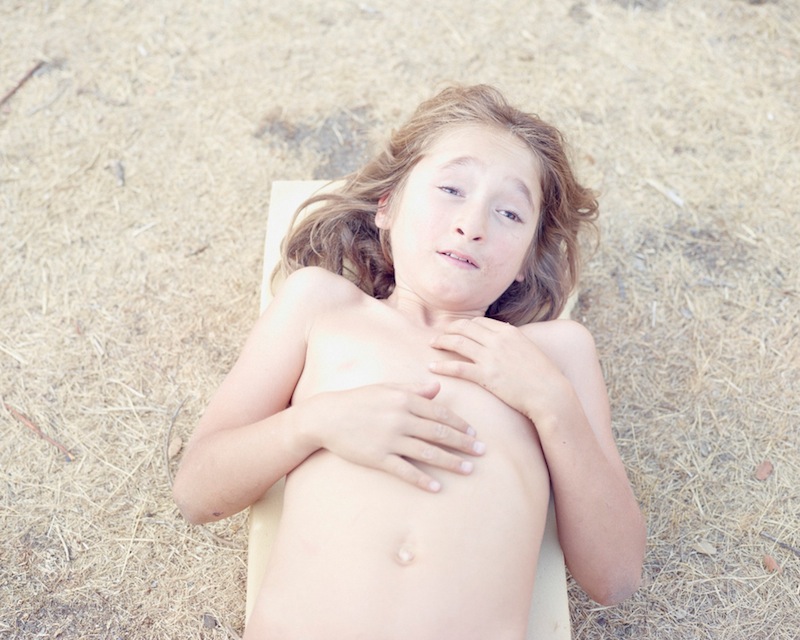Environmentally Conscious, Politically Active, Frequently Naked — Meet Europe’s Rewilders















Spanish photographer Jorge Fuembuena‘s series Wood Stories is part of our #EscapeWeek, a special series of photo essays dedicated to groups of people who, in one way or another, for one reason or another, have retired from urban society.
For Wood Stories, Jorge has photographed a series of communities across Europe which have joined the rewilding movement. Read our interview with him to find out more about Wood Stories. You can find links to all the other stories in our #EscapeWeek at the bottom of this article.
Hello Jorge, thank you for this interview. How did you take an interest in photography?
I studied fine art photography at the Escuela de Arte in Huesca, Spain, then I earned a scholarship to attend the Master Internacional de Fotografia de Autor at the European Institute of Design in Madrid, where I participated in workshops with the likes of Martin Parr, Joan Fontcuberta, Simon Roberts and more.
The communities you photographed are proponents of the rewilding movement. What is it about?
The rewilding movement is led by groups of people who look for an alternative lifestyle in the countryside, away from urban centers. They break away from society to go and live in the wild, with the goal of re-naturalizing deserted rural areas. These people have in common a profound respect for nature, they hold in high regard things like organic food, homeopathy and apiculture, they make candles and wood toys, etc. They recycle any disposed material and use solar, wind and water energy whenever possible.
Where were the pictures of Wood Stories taken?
They were taken in different ecovillages across Europe like Troglobal (France), Beneficio (Spain), Matavenero (Spain), etc.
Would you say that rewilding is really what these people are interested in, or are there reasons that may have to do with their individual life stories that pushed them to distance themselves from urban society?
Every person has a different story. I met people who made this choice because they had been unemployed for a long time, some who have rejected an economy based on consumerism, others were seeking a closer relationship with nature through silence and contemplation.
What I realized is these small communities are part of a very tight network, and when it is needed they reunite, such as in the case of the Zone a Défendre (tr. zone to be defended) in France. 500 people from around the world have temporarily established in the ZAD, amidst the woods, to impede the construction of an airport in that territory.
How are these communities organized? Are they self-sustained or do people have jobs?
They build their houses with local materials, hunt and grow their food in the effort of maintaining a self-sufficient lifestyle, and driven by environmental concerns. I’m especially interested in how their story is a sign of a tendency that we can see in our time.
There is a desire for solitude that can be traced back to authors like Henry David Thoreau. Thoreau was one of the founding fathers of American literature and a pioneering environmentalist, who theorized the idea of civil disobedience in his 1854 book Walden. The book is about communities which look for healthy environments to live in amidst the trees, along the rivers or underground. He invites us to question the functioning of our societies and our way of living.
What made you decide to explore the life of the rewilding communities?
Photography allows to explore and document the human ambition to dominate and possess, to occupy the landscape through the technological construction of nature. Wood Stories questions the urbanization plans that are undergoing in the areas where the pictures where taken. One of the way the space is represented in the images is through elements that obstruct the space itself, such as in the photos of barricades. There also is and idea of the territory as a map, of the past interpreted as the future, of destruction seen as construction. It’s a game of inversions.
After spending time with your subjects, have you ever considered joining them? Or at the very least, would you endorse such a lifestyle choice?
I worked on Wood Stories for about a year, during which I have lived within these communities. It was a very intense life experience. The relationships I have established with my subjects were fundamental: I wanted to connect with them.
Their lifestyle seems to me like a very healthy alternative. I observed a deep interest in the meaning of life among the people I met. I will re-visit some of them this year to host a photography workshop, and will see how the little ones are growing up.
From what you can tell, are they happier now? Do you know of someone who had second thoughts?
I don’t know if they are happier, but their eyes were sparkling. They live with people who share the same firm beliefs – this creates a reciprocity.
An essential factor for the well-functioning of these communities is how its members use their time and relate to the other members. There were individuals who were isolated from everybody else and didn’t seek their company. They became violent whenever someone went close to their space. I was also told that in some cases there had been inappropriate or selfish behaviors, and those responsible for such behaviors were expelled from the group.
Please share some insight into your creative process for Wood Stories.
I’m more concerned with how and why something is narrated, rather than what. Photography can be used for personal expression or for critical reflection, it can be about self-discovery or a way to explore the world around yourself. To me, photography is about ideas, about the semantic layers of meaning the photographer chooses to include. Space starts when we look further from where we are.
A few children appear in your photographs. How do you feel about parents indirectly imposing their new lifestyle on their children?
I think the way the children relate to their surroundings and the other children is actually healthier and more natural. They lead a very normal life, they play in the woods and swim in the rivers, they help their fathers when they work the land, they go to school everyday… They use technology very little, and so they are very smart and clever. They understand how the world works, the origin of life, nature’s cycles.
What camera(s) did you use to shoot Wood Stories?
A Sinar F and a Phase One iq180.
Choose your #threewordsforphotography.
Knowledge. Meaning. Reality.
***
Explore all the other stories in our #EscapeWeek:
Keep looking...

FotoCal — Photography Awards, Grants and Open Calls Closing in June 2023

FotoCal — Photography Awards, Grants and Open Calls Closing in May 2023

FotoCal — Photography Awards, Grants and Open Calls Closing in April 2023

FotoCal — Photography Awards, Grants and Open Calls Closing in March 2023

FotoCal — Photography Awards, Grants and Open Calls Closing in February 2023

FotoCal — Photography Awards, Grants and Open Calls Closing in January 2023

Discover the “Sweet and a Little Bit Sad” Photography of Annie Collinge



